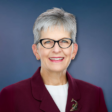New research speeds up quantum computing
“What we are pushing towards is to see this broadness of the supplication of using quantum computing to solve especially energy-related problems,” said Bo Peng.
May 30, 2025 9:30 am
6 min read
The Federal Drive with Terry Gerton provides expert insights on current events in the federal community. Read more interviews to keep up with daily news and analysis that affect the federal workforce. Reach out to Terry and the Federal Drive producers with feedback and story ideas at FederalDrive@federalnewsnetwork.com.

]]>
Interview transcript:
Terry Gerton Well, I have to tell you, I don’t know much about quantum computing, so in a couple of minutes, can you give me a basic understanding about what kind of problems require quantum computing to solve and what makes it so challenging?
Bo Peng Briefly speaking, quantum computing is just another type of computing. From my understanding, it’s basically just these like different mathematical representation than in conventional classical computing. So that means that it might not be universal. It might not the general choice for every single computational task you’re facing. So it mean that you have to design the problem in the first place. Then you think about if quantum computing which is based on the quantum mechanics can be used to solve that kind of problem. So yeah, in a nutshell, you have to really be familiar with quantum mechanics before you dive deep into quantum computing to see what kind of problem might be suitable for quantum computing.
]]>
Terry Gerton So like so many science problems, problem definition up front is the key piece of it. Your team has just recently published a breakthrough that simplifies the data preparation required for quantum computing. Tell us more about your discovery.
Bo Peng Yeah, so basically what we realized is regardless of the quantum algorithm you are developing, we are still living in the classical world. Which means the entire quantum computing workflow must be hybrid. Which means we have to prepare a translator to translate our classical data to something that can be dealt with by using the quantum computer. And then transfer back to our classical world such that we can read it. And then the key point in this process is how we are able to prepare those classical data such that a quantum computer can read and it can operate and it can output whatever that might be useful. And then our work is basically how we can prepare those —we call them quantum data — from classical data. And then actually that’s a pretty difficult task, it turns out, because even for a very small molecule or very small systems, it turns out it can be translated to like millions or even sometimes tens of millions of building blocks that would be used for the quantum computing. And then our work is basically to, by leveraging some existing classical computing facilities and algorithms, to streamline that data process step, so that makes it so efficient. And then this is one of the necessary building blocks in the modern quantum computing workflow. As I said, it must be hybrid. So before you step into the quantum computing, you have to use that step to prepare your quantum data.
Terry Gerton So I think I’m getting some of that. It’s all about making it easier for the computer to do its work, right?
Bo Peng Yeah, you can understand it like that.
Terry Gerton The process has a really cool name: Picasso. Tell us about why you picked that and how it relates to the data pre-processing.
Bo Peng Yeah, we named it after Picasso because based on the graph coloring processes, basically assume you are facing tens of millions of what we call the vertexes that just are single elements when you’re doing this quantum computing. What we want to do is you don’t want to like fit every single element into quantum computing in the first place. What you want to do is you group those elements in first place such that you reduce the number of those elements. And then to make it in a manageable size, and then you fit into quantum computer. And then in this process, there’s a very important algorithm called graph coloring. And then that’s why we associate with this process to the name, because we know that the artist also is good at manipulating the colors and of the artist masterpiece of work.
Terry Gerton I love that relating painting masterpieces to quantum computing masterpieces. I’m speaking with Dr. Bo Peng. He’s a computational scientist at the Department of Energy’s Pacific Northwest National Laboratory. So there’s another piece of this work that I find really fascinating. I mean, quantum computing is kind of an area of great power competition, especially between the U.S. and China. And you and your team published the code for this solution in the public domain, on Github. Tell us about why you made that choice.
]]>
Bo Peng Because we are a federal agency, we get our funding from taxpayers’ money. So what do we do? It must be serving the public and serving the people. So I think that’s the main motive why we make all our development open source.
Terry Gerton And who else besides the national labs will access this kind of information in an open source code space?
Bo Peng I think whoever is able to access GitHub should be able to access those development and those codes we’re developing.
Terry Gerton And so now that you’ve got them out there, you’ve tested this process, what is the impact on quantum computing specifically and maybe the impact on federal operations more generally?
Bo Peng Right now what we are pushing towards is to see this broadness of the supplication of using quantum computing to solve especially energy-related problems. As I said, very important aspect of the thinking about this entire process is whether we are able to design problems such that we can utilize this specific type of computation to solve. And then it’s not just, we’re not just sitting in the desk and just developing algorithm itself. We’re also seeking for useful applications, especially in our PNNL, we are thinking about if we can use quantum computing to solve like traditional quantum chemistry problem or power grid problem, which is associated with optimization or some other problems like in other classical computing territories. And this is still an active research area.
Terry Gerton And so what’s next for your research?
Bo Peng So right now, we’re focusing on those fundamental pieces and by focusing on building up a scalable and adaptable quantum classical framework. So it ranges from like what we did in this work, how we prepared the classical data in terms of translating it into the input for the quantum computing, and then solve this quantum problem that the corresponding quantum problem used in the existing quantum computer and then try to use the output to basically try to make the impact in some areas, especially energy-related areas. So within this workflow, the key point is the new mathematical representative and the development of one algorithm. And then what we’re doing, and what we have been doing so far, closely associated with that, scalable in depth and quantum classical workflow.
]]>
Copyright
© 2025 Federal News Network. All rights reserved. This website is not intended for users located within the European Economic Area.

